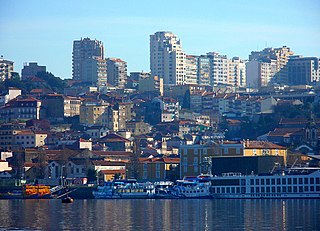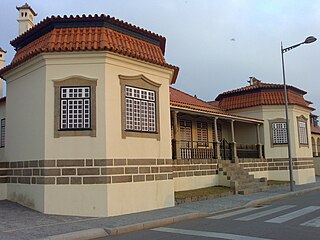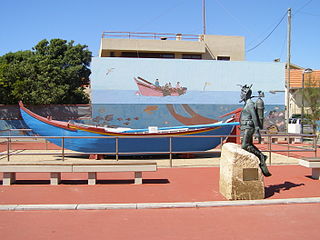
Praia, is the capital and largest city of Cape Verde, an island nation in the Atlantic Ocean west of Senegal. It lies on the southern coast of Santiago island in the Sotavento Islands group. It is the island's ferry port and is home to one of the nation's four international airports. The city centre is known as Plateau due to its location on a small plateau.

Vila Nova de Gaia, or simply Gaia, is a city and a municipality in Porto District in Norte Region, Portugal. It is located south of the city of Porto on the other side of the Douro River. The city proper had a population of 178,255 in 2001. The municipality has an area of 168.46 km². and a total population of 302,295 inhabitants (2011), making it the most populous municipality in Norte Region. Gaia together with Porto and 12 other municipalities makes up the commonly designated Porto Metropolitan Area.

Valadares is a former civil parish in the municipality of Vila Nova de Gaia, Portugal. In 2013, the parish merged into the new parish Gulpilhares e Valadares. The population in 2011 was 10,678, in an area of 5.14 km².
Vila Nova may refer to the following places:

Miramar is a small seaside village near the towns of Gulpilhares and Arcozelo, in the municipality of Vila Nova de Gaia, in the subregion of Greater Porto, Portugal.

Porto Covo is one of the two civil parishes in the municipality of Sines, located along the western Alentejo coast of Portugal, about 170 km (110 mi) south of Lisbon. The population in 2011 was 1,038, in an area of 50.72 km². Known for its beaches and ties to the ocean, the name Porto Covo likely translates as port of the covos, the term covo referring to a fishing net, used for capturing lobsters and crabs.

São Félix da Marinha is a Portuguese town and a parish in the municipality of Vila Nova de Gaia, in the district of Porto, in Northern Portugal. The population in 2011 was 12,706, in an area of 7.93 km².

Praia da Granja is a FEE Blue Flag beach located in the Northwest of Portugal, and belongs to the Vila Nova de Gaia municipality, Porto District. This place is also located in the town of São Félix da Marinha. The northern boundary of the beach is bordered by the Ribeira da Granja.
Manuel Jorge da Silva Cruz, known as Tulipa, is a Portuguese retired footballer who played as a midfielder, and is a manager.

The Fort of São João Baptista is the ruins of a 16th-century maritime fort situated on the western edge of Praia Formoso, in the civil parish of Almagreira, municipality of Vila do Porto, on the Portuguese island of Santa Maria.

Augusto Ernesto dos Santos Silva, OMRI is the Portuguese Minister of Foreign Affairs and a university professor.
Vila Nova de Gaia is one of the leading tourism destinations in northern Portugal, located directly opposite Porto, on the South bank of Douro river. These two cities interconnect with each other through several bridges over Douro river. Vila Nova de Gaia is home to several notable attractions, such as the Port wine cellars, Dom Luís I Bridge, the Teleferico, Monastery of Serra do Pilar, Douro Estuary and 18 km long beaches.













